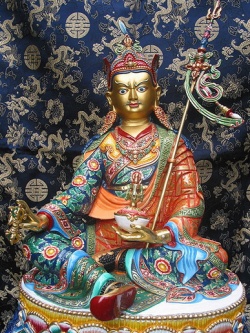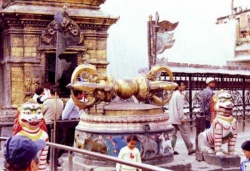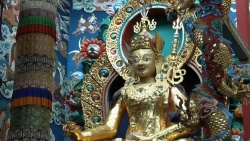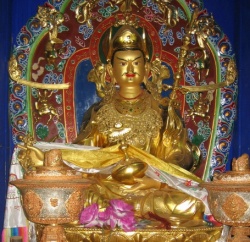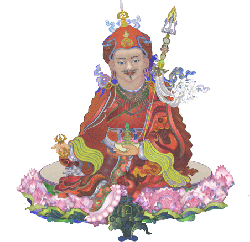Difference between revisions of "Atiyoga"
| (24 intermediate revisions by 5 users not shown) | |||
| Line 1: | Line 1: | ||
| − | < | + | <br/><br/><br/> |
| − | + | {{Template:9yanas articles | |
| + | |title=9. Yana of atiyoga | ||
| + | |sanskrit=atiyoga yāna | ||
| + | |tibetan={{BigTibetan|[[ཤིན་ཏུ་རྣལ་འབྱོར་གྱི་ཐེག་པ་]]}} | ||
| + | |phonetics=[[shintu naljor kyi tekpa]] | ||
| − | |||
| − | |||
| − | |||
| − | |||
| − | + | |[[wylie]]=[[shin tu rnal 'byor gyi theg pa]] | |
| − | + | }} | |
| + | '''[[Atiyoga]]''' (Skt.; Tib. {{BigTibetan|[[ཤིན་ཏུ་རྣལ་འབྱོར་]]}}, [[Wyl.]] ''[[shin tu rnal 'byor]]'') — the [[highest]] [[yana]] within the {{Wiki|classification}} of [[nine yanas]] of the [[Nyingma]] school. [[Atiyoga]] is {{Wiki|synonymous}} with [[Dzogchen]]. | ||
| − | |||
| − | |||
| − | |||
| − | + | [[Atiyoga]] | |
| − | |||
| − | |||
| − | + | {{Wiki|Synonymous}} with [[Dzogchen]]. The term ‘[[Atiyoga]]’ is used when classifying [[yanas]] in terms of the [[nine-yana]] [[Nyingma]] system. In that system, [[Atiyoga]] is regarded as the third of the [[inner Tantras]]. [[Dzogchen]] is the term used within the [[Dzogchen’s]] [[own]] three-yana categorisation. | |
| − | |||
| − | |||
| − | |||
| − | |||
| − | + | ==Overview Given by [[Alak Zenkar Rinpoche]]<ref>{{LH|tibetan-masters/alak-zenkar/nine-yanas|''A Brief Presentation of the Nine Yanas'' by Alak Zenkar Rinpoche}}</ref>== | |
| − | |||
| − | |||
| − | |||
| − | Perfecting the four visions of the path, one gains the supreme kaya, the [[ | + | The [[vehicle]] of [[Atiyoga]], or ‘[[Utmost Yoga]],’ is so-called because it is the [[highest]] of all vehicles. It involves the [[realization]] that all [[phenomena]] are nothing other than the [[appearances]] of the naturally [[arising]] [[primordial wisdom]] which has always been beyond [[arising]] and ceasing. |
| − | </ | + | |
| + | |||
| + | ===Entry Point=== | ||
| + | |||
| + | |||
| + | One’s [[mind]] is matured through the four ‘expressive power of [[awareness]]’ [[empowerments]] (Tib. {{BigTibetan|[[རིག་པའི་རྩལ་དབང་]]}}, ''[[rigpé tsal wang]]''), and one keeps the [[samaya]]s as explained in the texts. | ||
| + | |||
| + | |||
| + | ===[[View]]=== | ||
| + | |||
| + | |||
| + | [[Image:Samantabhadra.jpg|thumb|150px|The Primordial Buddha [[Samantabhadra]])] | ||
| + | The [[view]] is definitively established by looking directly into the naturally [[arising]] [[wisdom]] in which the [[three kayas]] are [[inseparable]]: the [[essence|empty essence]] of [[naked awareness]] beyond the [[ordinary mind]] is the [[dharmakaya]], its [[nature|cognizant nature]] is the [[sambhogakaya]], and its [[compassionate energy - all-pervasive compassionate energy]] is the [[nirmanakaya]]. | ||
| + | |||
| + | |||
| + | ===[[Meditation]]=== | ||
| + | |||
| + | |||
| + | The [[meditation]] consists of the approach of [[cutting through resistance]] to [[primordial purity]] (Tib. ''[[kadak trekchö]]''), through which the lazy can reach [[liberation]] without [[effort]], and the approach of the [[direct realization]] of [[spontaneous presence]] (Tib. ''[[lhundrup tögal]]''), through which the diligent can reach [[liberation]] with {{Wiki|exertion}}. | ||
| + | |||
| + | |||
| + | ===Conduct=== | ||
| + | |||
| + | |||
| + | The conduct is free from {{Wiki|hope}} and {{Wiki|fear}} and adopting and [[abandoning]], because all that appears [[manifests]] as the display of [[reality]] itself. | ||
| + | |||
| + | |||
| + | ===Results=== | ||
| + | |||
| + | |||
| + | Perfecting the [[four visions]] of the [[path]], one gains the supreme [[kaya]], the [[rainbow body of great transference]] (see [[rainbow body]]), and attains the level of glorious [[Samantabhadra]], the thirteenth [[bhumi]] known as ‘Unexcelled [[Wisdom]]’ (''[[yeshe lama]]''). | ||
| + | |||
| + | {{reflist}} | ||
| + | |||
| + | |||
| + | ==Further Reading== | ||
| + | |||
| + | |||
| + | {{Nolinking|*[[Jamgön Kongtrul]], ''The Treasury of Knowledge, Book Six, Part Four: Systems of Buddhist Tantra'', translated by Elio Guarisco and Ingrid McLeod (Ithaca: Snow Lion, 2005), pages 337-346.}} | ||
| + | |||
| + | {{RigpaWiki}} | ||
| + | {{NewSourceBreak}} | ||
| + | [[File:Sd500.jpg|thumb|250px|]] | ||
| + | |||
| + | The [[extraordinary]] feature of [[Atiyoga]] is that the [[practitioner]] maintains lucid [[recognition]] of the [[Wikipedia:Absolute (philosophy)|ultimate]] [[nature]] of [[mind]]: [[pure]], vividly clear, {{Wiki|perfect}} in itself. It is [[luminosity]] that is naturally {{Wiki|present}}, [[self-existing]] [[primordial wisdom]], without any [[alteration]] or [[fabrication]], [[beyond]] taking or rejecting, {{Wiki|hope}} and {{Wiki|fear}}. | ||
| + | |||
| + | |||
| + | This is the “[[Wikipedia:Absolute (philosophy)|ultimate]] [[yoga]],” far surpassing all the lower [[vehicles]] that entail striving, [[fabrication]], and [[effort]]. [[Atiyoga]] is also known as [[Dzogchen]], the [[Great Perfection]], meaning that all [[phenomena]] are naturally {{Wiki|perfect}} in their [[primordial purity]]. | ||
| + | |||
| + | Its gateway is the [[empowerment]] of the “creative power of [[awareness]].” According to the [[Secret Heart Essence]], the [[practitioner]] receives [[four empowerments]]: elaborate, unelaborate, very unelaborate, and utterly unelaborate. | ||
| + | |||
| + | |||
| + | [[View]]: All [[phenomena]] within both [[samsara]] and [[nirvana]] are {{Wiki|perfect}} in [[primordial]] [[buddhahood]], the great [[sphere]] of [[Dharmakaya]], the [[self-existing]] pristine [[wisdom]] [[beyond]] searching and [[effort]]. | ||
| + | |||
| + | [[Atiyoga]] has [[three classes]]. The first is meant for {{Wiki|individuals}} who are concerned with the workings of [[mind]], the second is intended for {{Wiki|individuals}} whose [[minds]] are like the sky, and the third is for {{Wiki|individuals}} whose temperaments transcend all [[effort]]. | ||
| + | |||
| + | |||
| + | |||
| + | According to the [[mind-class]], all [[perceived]] [[phenomena]] are none other than the play of mind-as-such, the inexpressible, [[self-existing]] [[wisdom]]. | ||
| + | |||
| + | According to the [[space-class]], [[self-existing]] [[wisdom]] and all [[phenomena]] sprung from its {{Wiki|continuum}} never stray from the expanse of [[Samantabhadri]]. They have always been [[pure]] and {{Wiki|liberated}}. | ||
| + | |||
| + | According to the most [[extraordinary]] of the three, the class of [[pith instructions]], regarding the [[true nature]] of [[samsara]] and [[nirvana]] there are no [[obscurations]] to be rid of and no [[enlightenment]] to be acquired. To realize this allows an instantaneous [[arising]] of the [[self-existing]] [[wisdom]] [[beyond]] {{Wiki|intellect}}. | ||
| + | |||
| + | [[File:Vajra nepal.jpg|thumb|250px|]] | ||
| + | [[Meditation]]: In the [[mind-class]], having [[recognized]] that all [[phenomena]] are the [[indescribable]] [[Dharmakaya]], the [[self-existing]] [[wisdom]], the [[practitioner]] rests in the {{Wiki|continuum}} of the awareness-void in which there is [[nothing]] to [[illuminate]], [[nothing]] to reject, and [[nothing]] to add. The [[enlightened mind]] is like [[infinite space]], its potential for [[manifestation]] is like a [[mirror]], and {{Wiki|limitless}} [[illusory]] [[phenomena]] are like multifarious reflections in that [[mirror]]. Since everything arises as the play of the [[enlightened mind]], there is no need to obstruct the [[arising]] of [[thoughts]]. The [[practitioner]] simply remains in the natural [[condition]] of mind-as-such. | ||
| + | |||
| + | |||
| + | |||
| + | In the [[space-class]], having [[recognized]] that all [[phenomena]] never leave the expanse of [[Samantabhadri]] and are [[primordially pure]] and free, the [[practitioner]] abides in the {{Wiki|continuum}} of the [[Wikipedia:Absolute (philosophy)|ultimate]] [[nature]] without targets, [[effort]], or searching. There is no need to use [[antidotes]]: being [[void]], [[thoughts]] and [[perceptions]] vanish by themselves. [[Phenomena]] are like {{Wiki|stars}} naturally arrayed as ornaments in the {{Wiki|firmament}} of the [[absolute nature]]. There is no need to consider, as is done in the [[mind-class]], that they arise as the play of [[awareness]]. Everything is the [[infinite]] expanse of [[primordial]] [[liberation]]. | ||
| + | |||
| + | |||
| + | |||
| + | In the class of [[pith instructions]], having [[recognized]] that mind-as-such is [[primordially pure]] [[emptiness]], we practice [[trekcho]] ([[khregs chod]]), leaving [[mind]] and all [[phenomena]] in their [[natural state]] of pristine [[liberation]]. [[Trekcho]], “cutting through {{Wiki|hardness}} (or concreteness),” refers to breaking through the {{Wiki|solidity}} of [[mental]] [[clinging]]. Then, having discovered the naturally {{Wiki|present}} [[mandala]] of the [[body]], [[togal]] ([[thod rgal]]) is practiced and the very face of the naturally {{Wiki|present}} [[luminosity]], the pristine [[wisdom]] that dwells within, is seen. | ||
| + | |||
| + | |||
| + | |||
| + | Without leaning toward the “clarity” aspect of the [[mind-class]] or toward the “[[void]]” aspect of the [[space-class]], without considering the [[self-liberation]] of [[thoughts]] (as in the [[mind-class]]) or the way of letting them be in [[emptiness]] (as in the [[space-class]]), the [[practitioner]] simply rests with [[unaltered]] [[simplicity]] in the confident [[realization]] of [[primordial purity]] that is inexpressible, [[beyond]] {{Wiki|intellect}}, and of which [[phenomena]] are the natural radiance. | ||
| + | |||
| + | |||
| + | Two [[extraordinary]] practices are found only in the teachings of the [[Great Perfection]]. [[Togal]], or, “direct leap,” refers to going directly to the [[highest]] point of [[realization]]. These two are related respectively to [[primordial purity]] and [[spontaneous presence]]. It is said that the first eight [[vehicles]] use [[mind]] as the [[path]], and that only the ninth one uses [[awareness]] as the [[path]]. | ||
| + | [[File:Reoch 4.jpg|thumb|250px|]] | ||
| + | |||
| + | |||
| + | [[Action]]: Since everything that arises is the play of the [[absolute nature]], the [[practitioner]] acts within the {{Wiki|continuum}} of [[non-dual]] evenness, without taking and rejecting, free from [[clinging]] and fixation. | ||
| + | |||
| + | |||
| + | Fruit: The [[practitioner]] dwells directly on the level of the Ever-perfect, [[Samantabhadra]]. Since outer [[phenomena]] have been mastered, they are [[realized]] as [[infinite]] [[buddhafields]]; since the inner [[aggregates]] of the [[illusory body]] have been mastered, this [[body]] can turn into [[radiant light]]; having mastered the innermost expanse of [[awareness]], the [[practitioner]] puts an end to [[delusion]]. There is neither {{Wiki|hope}} of [[attaining]] [[buddhahood]], nor {{Wiki|fear}} of falling into [[samsara]]. As it is said: | ||
| + | |||
| + | |||
| + | The fruit of the [[Great Perfection]] | ||
| + | |||
| + | Is [[primordially]] {{Wiki|present}} as the [[Buddha nature]]. | ||
| + | |||
| + | It does not need to be obtained: | ||
| + | |||
| + | It is ripe within oneself. | ||
| + | |||
| + | As said above, the [[nine vehicles]] do not represent separate [[paths]]. Each of them is a step toward the next; all [[vehicles]] ultimately culminate in the [[Great Perfection]]. | ||
| + | |||
| + | |||
| + | {{R}} | ||
| + | [http://www.treasuryoflives.org/foundations/view/8 treasuryoflives.org] | ||
| + | {{NewSourceBreak}} | ||
| + | |||
| + | [[Ati Yoga]]<br/> | ||
| + | Skt., [[atiyoga]]<br/> | ||
| + | Tib., shin-Tu rNal-'Byor <br/> | ||
| + | |||
| + | Also known as [[Non-Dual Tantras]] (Skt., advitiatantra) outside [[The Nyingma Tradition]]; [[Ati Yoga]] belongs to the [[Inner Tantras]] and constitutes level 9 of the [[Nine Vehicles]]. These teachings are also known as [[Dzogchen]] (Tib., rDzogs-pa ch'en-po) and as [[Primordial Yoga]] (Tib., gdod-ma'i [[rnal-'byor]]). | ||
| + | [[File:Padma dod.jpg|thumb|250px|]] | ||
| + | |||
| + | |||
| + | This is the level of all the [[Dzogchen]], [[Lamdre]], and [[Mahamudra]] teachings, and represents the [[highest]] possible [[achievement]], the unification of [[path]] and goal that leads one to true [[Buddhahood]]. On this level, one learns about the equality and union of the two earlier stages (7 and 8) and in practice, {{Wiki|emphasis}} is put on entering the [[state]] of absolutely [[non-discriminating contemplation]] (Tib., [[ting-nge-'dzin]]; Skt., [[Samadhi]]). | ||
| + | |||
| + | '''[[Initiations]]: | ||
| + | |||
| + | In addition to the [[initiations]] of the previous stages, the [[practitioner]] now receives [[the fourth]] or [[Word Initiation]] (Tib., tshig-dbang, Skt., caturthabhiseka), which [[empowers]] her or him to receive and understand this "[[Highest Yoga Tantra]]". | ||
| + | |||
| + | '''Texts and Teachings: | ||
| + | |||
| + | The [[Dzogchen]]/[[Atiyoga]] teachings, introduced into [[Tibet]] by [[Vairochana]], [[Vimalamitra]] and [[Padmasambhava]], consist of [[three classes]] or series of texts: | ||
| + | |||
| + | : 9.1 [[Semde]] ([[sems-sde]]) [[Mind Series]] | ||
| + | : 9.2 [[Longde]] ([[klong-sde]]) [[Space Series]] | ||
| + | : 9.3 [[Mannagde]] ([[man-ngag gi sde]]) [[Secret Instruction Serie]] | ||
| + | |||
| + | {{R}} | ||
| + | |||
| + | [http://yoniversum.nl/dakini/tantib9.html yoniversum.nl] | ||
| + | {{NewSourceBreak}} | ||
| + | The third of [[The Three Inner Tantras]]. It emphasizes, according to [[Jamgon Kongtrul]] the First, the [[view]] that [[Liberation]] is [[attained]] through growing accustomed to [[Insight]] into the [[nature]] of [[primordial]] [[Enlightenment]], free from accepting and rejecting, {{Wiki|hope}} and {{Wiki|fear}}. The more common [[word]] for [[Ati Yoga]] nowadays is '[[Dzogchen]].' The [[Ati Yoga]] teachings first appeared in this [[World]] to [[Garab Dorje]] in The country of [[Uddiyana]] to the [[west]] of [[India]]. | ||
| + | |||
| + | According to The Narration of the [[Precious]] [[Revelation]] of the [[Terma]] [[Treasures]] by [[Longchen Rabjam]] (p. 87-88), the [[great master]] [[Padmasambhava]] described the [[teaching]] of [[Ati Yoga]] in the following way before imparting them to [[Yeshe Tsogyal]]: | ||
| + | [[File:Padma VTao.gif|thumb|250px|]] | ||
| + | |||
| + | |||
| + | "It is an instruction unlike any I have given in the {{Wiki|past}}, the summit that {{Wiki|transcends}} all of the [[nine gradual vehicles]]. By [[seeing]] its [[vital]] point, [[Mind]]-made [[views]] and [[meditations]] are shattered. The [[paths]] and levels are perfected with no need for struggle. [[Disturbing emotions]] are {{Wiki|liberated}} into their [[natural state]] without any need for reform or remedy. This instruction brings [[realization]] of a [[fruition]] within oneself that is not | ||
| + | |||
| + | produced from [[causes]]. It instantly brings forth spontaneously {{Wiki|present}} [[realization]], {{Wiki|liberates}} the material [[Body]] of flesh and {{Wiki|blood}} into the {{Wiki|luminous}} [[Sambhogakaya]] within this very [[lifetime]], and enables you to capture the [[permanent]] abode, the [[precious]] [[Dharmakaya]] [[realm]] of [[spontaneous presence]], within three years, in the domain of [[Akanishtha]]. I possess such an instruction and I shall teach it to you!" | ||
| + | |||
| + | |||
| + | [[Ati Yoga]] is a {{Wiki|synonym}} for [[Great Perfection]] and [[Dzogchen]]. | ||
{{R}} | {{R}} | ||
| − | [http://www. | + | [http://www.rangjung.com/gl/Ati_Yoga.htm rangjung.com] |
| − | + | ||
| − | + | ||
[[Category:Nyingma]] | [[Category:Nyingma]] | ||
[[Category:Atiyoga]] | [[Category:Atiyoga]] | ||
| + | [[Category:Nine Yanas]] | ||
Latest revision as of 19:11, 22 April 2023
| The Nine Yanas |
| 9. Yana of atiyoga |
| Skt. atiyoga yāna |
| Tib. ཤིན་ཏུ་རྣལ་འབྱོར་གྱི་ཐེག་པ་ |
| shintu naljor kyi tekpa |
| Wyl. {{{wylie}}} |
| Read main article for nine yana overview |
| Three Outer Yanas Leading From the Origin |
| 1. Shravaka yana |
| 2. Pratyekabuddha yana |
| 3. Bodhisattva yana |
| Three Yanas of Vedic Asceticism |
| 4. Yana of kriya tantra |
| 5. Yana of charya tantra |
| 6. Yana of yoga tantra |
| Three Yanas of Powerful Transformative Methods |
| 7. Yana of tantra mahayoga |
| 8. Yana of scriptural transmission anuyoga |
| 9. Yana of pith instruction atiyoga |
Atiyoga (Skt.; Tib. ཤིན་ཏུ་རྣལ་འབྱོར་, Wyl. shin tu rnal 'byor) — the highest yana within the classification of nine yanas of the Nyingma school. Atiyoga is synonymous with Dzogchen.
Synonymous with Dzogchen. The term ‘Atiyoga’ is used when classifying yanas in terms of the nine-yana Nyingma system. In that system, Atiyoga is regarded as the third of the inner Tantras. Dzogchen is the term used within the Dzogchen’s own three-yana categorisation.
Overview Given by Alak Zenkar Rinpoche[1]
The vehicle of Atiyoga, or ‘Utmost Yoga,’ is so-called because it is the highest of all vehicles. It involves the realization that all phenomena are nothing other than the appearances of the naturally arising primordial wisdom which has always been beyond arising and ceasing.
Entry Point
One’s mind is matured through the four ‘expressive power of awareness’ empowerments (Tib. རིག་པའི་རྩལ་དབང་, rigpé tsal wang), and one keeps the samayas as explained in the texts.
View
[[Image:Samantabhadra.jpg|thumb|150px|The Primordial Buddha Samantabhadra)] The view is definitively established by looking directly into the naturally arising wisdom in which the three kayas are inseparable: the empty essence of naked awareness beyond the ordinary mind is the dharmakaya, its cognizant nature is the sambhogakaya, and its compassionate energy - all-pervasive compassionate energy is the nirmanakaya.
Meditation
The meditation consists of the approach of cutting through resistance to primordial purity (Tib. kadak trekchö), through which the lazy can reach liberation without effort, and the approach of the direct realization of spontaneous presence (Tib. lhundrup tögal), through which the diligent can reach liberation with exertion.
Conduct
The conduct is free from hope and fear and adopting and abandoning, because all that appears manifests as the display of reality itself.
Results
Perfecting the four visions of the path, one gains the supreme kaya, the rainbow body of great transference (see rainbow body), and attains the level of glorious Samantabhadra, the thirteenth bhumi known as ‘Unexcelled Wisdom’ (yeshe lama).
Footnotes
Further Reading
- Jamgön Kongtrul, The Treasury of Knowledge, Book Six, Part Four: Systems of Buddhist Tantra, translated by Elio Guarisco and Ingrid McLeod (Ithaca: Snow Lion, 2005), pages 337-346.
Source
The extraordinary feature of Atiyoga is that the practitioner maintains lucid recognition of the ultimate nature of mind: pure, vividly clear, perfect in itself. It is luminosity that is naturally present, self-existing primordial wisdom, without any alteration or fabrication, beyond taking or rejecting, hope and fear.
This is the “ultimate yoga,” far surpassing all the lower vehicles that entail striving, fabrication, and effort. Atiyoga is also known as Dzogchen, the Great Perfection, meaning that all phenomena are naturally perfect in their primordial purity.
Its gateway is the empowerment of the “creative power of awareness.” According to the Secret Heart Essence, the practitioner receives four empowerments: elaborate, unelaborate, very unelaborate, and utterly unelaborate.
View: All phenomena within both samsara and nirvana are perfect in primordial buddhahood, the great sphere of Dharmakaya, the self-existing pristine wisdom beyond searching and effort.
Atiyoga has three classes. The first is meant for individuals who are concerned with the workings of mind, the second is intended for individuals whose minds are like the sky, and the third is for individuals whose temperaments transcend all effort.
According to the mind-class, all perceived phenomena are none other than the play of mind-as-such, the inexpressible, self-existing wisdom.
According to the space-class, self-existing wisdom and all phenomena sprung from its continuum never stray from the expanse of Samantabhadri. They have always been pure and liberated.
According to the most extraordinary of the three, the class of pith instructions, regarding the true nature of samsara and nirvana there are no obscurations to be rid of and no enlightenment to be acquired. To realize this allows an instantaneous arising of the self-existing wisdom beyond intellect.
Meditation: In the mind-class, having recognized that all phenomena are the indescribable Dharmakaya, the self-existing wisdom, the practitioner rests in the continuum of the awareness-void in which there is nothing to illuminate, nothing to reject, and nothing to add. The enlightened mind is like infinite space, its potential for manifestation is like a mirror, and limitless illusory phenomena are like multifarious reflections in that mirror. Since everything arises as the play of the enlightened mind, there is no need to obstruct the arising of thoughts. The practitioner simply remains in the natural condition of mind-as-such.
In the space-class, having recognized that all phenomena never leave the expanse of Samantabhadri and are primordially pure and free, the practitioner abides in the continuum of the ultimate nature without targets, effort, or searching. There is no need to use antidotes: being void, thoughts and perceptions vanish by themselves. Phenomena are like stars naturally arrayed as ornaments in the firmament of the absolute nature. There is no need to consider, as is done in the mind-class, that they arise as the play of awareness. Everything is the infinite expanse of primordial liberation.
In the class of pith instructions, having recognized that mind-as-such is primordially pure emptiness, we practice trekcho (khregs chod), leaving mind and all phenomena in their natural state of pristine liberation. Trekcho, “cutting through hardness (or concreteness),” refers to breaking through the solidity of mental clinging. Then, having discovered the naturally present mandala of the body, togal (thod rgal) is practiced and the very face of the naturally present luminosity, the pristine wisdom that dwells within, is seen.
Without leaning toward the “clarity” aspect of the mind-class or toward the “void” aspect of the space-class, without considering the self-liberation of thoughts (as in the mind-class) or the way of letting them be in emptiness (as in the space-class), the practitioner simply rests with unaltered simplicity in the confident realization of primordial purity that is inexpressible, beyond intellect, and of which phenomena are the natural radiance.
Two extraordinary practices are found only in the teachings of the Great Perfection. Togal, or, “direct leap,” refers to going directly to the highest point of realization. These two are related respectively to primordial purity and spontaneous presence. It is said that the first eight vehicles use mind as the path, and that only the ninth one uses awareness as the path.
Action: Since everything that arises is the play of the absolute nature, the practitioner acts within the continuum of non-dual evenness, without taking and rejecting, free from clinging and fixation.
Fruit: The practitioner dwells directly on the level of the Ever-perfect, Samantabhadra. Since outer phenomena have been mastered, they are realized as infinite buddhafields; since the inner aggregates of the illusory body have been mastered, this body can turn into radiant light; having mastered the innermost expanse of awareness, the practitioner puts an end to delusion. There is neither hope of attaining buddhahood, nor fear of falling into samsara. As it is said:
The fruit of the Great Perfection
Is primordially present as the Buddha nature.
It does not need to be obtained:
It is ripe within oneself.
As said above, the nine vehicles do not represent separate paths. Each of them is a step toward the next; all vehicles ultimately culminate in the Great Perfection.
Source
Ati Yoga
Skt., atiyoga
Tib., shin-Tu rNal-'Byor
Also known as Non-Dual Tantras (Skt., advitiatantra) outside The Nyingma Tradition; Ati Yoga belongs to the Inner Tantras and constitutes level 9 of the Nine Vehicles. These teachings are also known as Dzogchen (Tib., rDzogs-pa ch'en-po) and as Primordial Yoga (Tib., gdod-ma'i rnal-'byor).
This is the level of all the Dzogchen, Lamdre, and Mahamudra teachings, and represents the highest possible achievement, the unification of path and goal that leads one to true Buddhahood. On this level, one learns about the equality and union of the two earlier stages (7 and 8) and in practice, emphasis is put on entering the state of absolutely non-discriminating contemplation (Tib., ting-nge-'dzin; Skt., Samadhi).
In addition to the initiations of the previous stages, the practitioner now receives the fourth or Word Initiation (Tib., tshig-dbang, Skt., caturthabhiseka), which empowers her or him to receive and understand this "Highest Yoga Tantra".
Texts and Teachings:
The Dzogchen/Atiyoga teachings, introduced into Tibet by Vairochana, Vimalamitra and Padmasambhava, consist of three classes or series of texts:
- 9.1 Semde (sems-sde) Mind Series
- 9.2 Longde (klong-sde) Space Series
- 9.3 Mannagde (man-ngag gi sde) Secret Instruction Serie
Source
The third of The Three Inner Tantras. It emphasizes, according to Jamgon Kongtrul the First, the view that Liberation is attained through growing accustomed to Insight into the nature of primordial Enlightenment, free from accepting and rejecting, hope and fear. The more common word for Ati Yoga nowadays is 'Dzogchen.' The Ati Yoga teachings first appeared in this World to Garab Dorje in The country of Uddiyana to the west of India.
According to The Narration of the Precious Revelation of the Terma Treasures by Longchen Rabjam (p. 87-88), the great master Padmasambhava described the teaching of Ati Yoga in the following way before imparting them to Yeshe Tsogyal:
"It is an instruction unlike any I have given in the past, the summit that transcends all of the nine gradual vehicles. By seeing its vital point, Mind-made views and meditations are shattered. The paths and levels are perfected with no need for struggle. Disturbing emotions are liberated into their natural state without any need for reform or remedy. This instruction brings realization of a fruition within oneself that is not
produced from causes. It instantly brings forth spontaneously present realization, liberates the material Body of flesh and blood into the luminous Sambhogakaya within this very lifetime, and enables you to capture the permanent abode, the precious Dharmakaya realm of spontaneous presence, within three years, in the domain of Akanishtha. I possess such an instruction and I shall teach it to you!"
Ati Yoga is a synonym for Great Perfection and Dzogchen.
